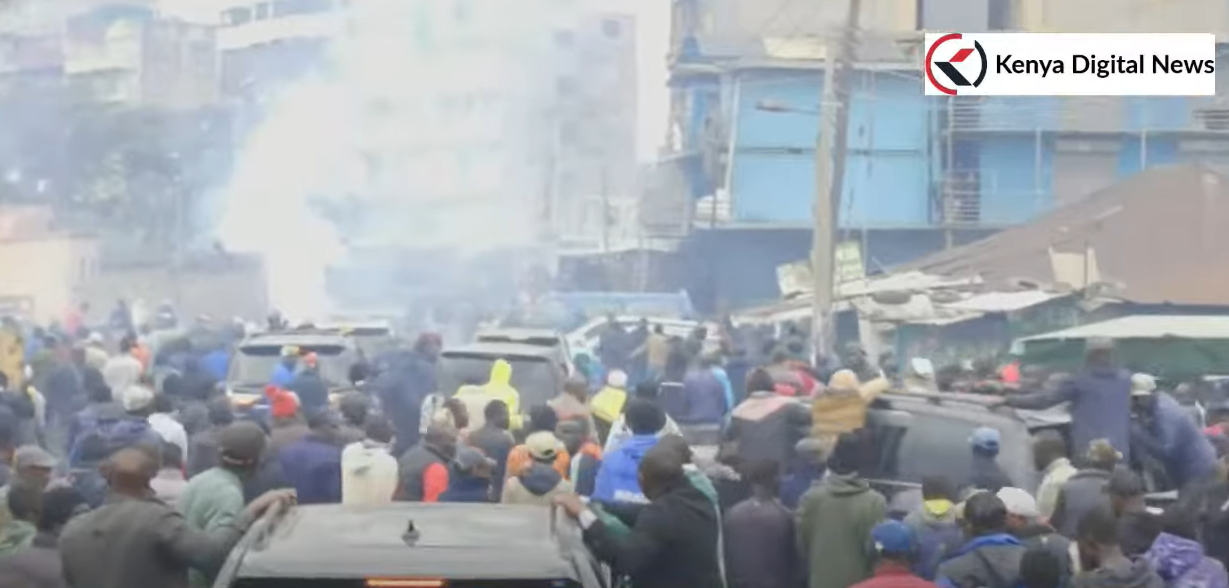 Dispatches
DispatchesAynsley Genga is a JURIST Senior Correspondent in Kenya. She files this dispatch from Nairobi.
July 7th, also known as Saba Saba (7-7), is a very significant and historical day for Kenya as a nation. It was on this day 33 years ago, in 1990, that Kenyans all over the country took to the streets to not only demand free and fair elections but also demand the restoration of multiparty democracy. The day will forever be enshrined in Kenyan history due to the fact that Kenyans united as one, regardless of tribal differences, to fight for a common cause in an era where everyone was leaving in fear that outright opposition of the government could lead to the person being sent to Nyayo torture chambers, a place where few ever returned from with their mind or body intact. Saba Saba is therefore a very significant day for Kenya’s democracy.
As the saying goes, history repeats itself. 33 years since the first Saba Saba, Kenyans took to the streets today in numbers. Demonstrations organized by opposition leader Raila Odinga and his Party were held all over the country. There were demonstrations in Nairobi County, Kirinyaga County, Vihiga County, Kisii County, Mombasa County, Narok County and even in Lodwar town. Kenyans came out to protest against the high cost of living. Living in Kenya was already expensive but after the government recently passed the controversial Finance Bill, living in Kenya is going to become unbearable for most Kenyans. Fuel prices have already been increased despite the fact the the High Court had suspended the implementation of the new Finance Act, 2023 until the court gives its ruling on 10th July.
Protesters take to the streets as Saba Saba demos kick off in various parts of the country including Machakos, Kisii and Mombasa. pic.twitter.com/pBznmOltc1
— Citizen TV Kenya (@citizentvkenya) July 7, 2023
Kenyans in Nairobi made their way to the Kamukunji grounds (the same grounds where the first Saba Saba was held) in order to listen what Raila had to say. Most began making their way to the grounds very early in the morning battling the cold and rainy weather in order to make it on time. When Raila arrived the crowd in Kamukunji went wild and were very eager to hear what his plans for the nations were. Raila declared that he and his party, Azimio, would continue with their acts of civil disobedience and he encouraged Kenyans to do so as well. He further declared that the protests would continue and that on July 12th another nationwide protest is to take place. Raila promised that the demonstration would not end until President Ruto brings an end to the high cost of living. He further informed Kenyans of his plan to collect 10 million signatures demanding the removal of President Ruto from office. Videos of people collecting signatures in different parts of the country are already spreading online. Moreover, Raila demanded that the government be transparent as well as involve all parties in the choosing of the Independent Electoral and Boundaries Commission (IEBC) Commissioners. He stated that if the government does not comply with the law when it comes to the selection process of the IEBC commissioners, then he and his supports will form their own electoral commission.
“We are tired, tumechoka!” Hundreds of Azimio supporters leave Kamukunji Grounds for Nairobi CBD after address by Raila Odinga. pic.twitter.com/nPXTr7Mi6D
— Citizen TV Kenya (@citizentvkenya) July 7, 2023
Azimio leader Raila Odinga launches signature drive at Saba Saba Kamukunji rally. They plan to collect 10 million signatures by Friday next week.#Maandamano pic.twitter.com/3cdGwbnXH9
— KTN News (@KTNNewsKE) July 7, 2023
After Raila made his speech to the masses he then made his way to the Nairobi Central Business District (CBD) and for the first time since he began the demonstration wave this year, Raila finally managed to bypass the police blockade through the use of motorbike (bodaboda). In fact, the police were so preoccupied with the crowd following him which made it easier for him to slip through since nobody expected him to use a bodaboda. Due to this, Nairobi CBD became basically a no-go zone since the police were throwing teargas at everyone and attacking protestors on sight. The chaos in Nairobi started when the police began attacking protestors which in turn caused the protestors to retaliate. Article 37 of the Constitution of Kenya (CoK) allows for Kenyans to peacefully protest, so why is it time and time again incidences of police brutality during demonstrations has remained prevalent in Kenya? Many demonstrators were arrested today and this includes politicians such as the former Laikipia County Governor Nderitu Mureithi who was in charge of leading the protests in Nyahururu town.
Police lob teargas to disperse Saba Saba protesters trying to access Nairobi's CBD; Azimio leader Raila Odinga makes his way on a boda boda. pic.twitter.com/o7pekzv1ia
— Citizen TV Kenya (@citizentvkenya) July 7, 2023
Former Laikipia governor Nderitu Murrithi, a host of Azimio supporters arrested as they conducted Saba saba protests in Nyahururu town. pic.twitter.com/MYK3UyubuE
— Citizen TV Kenya (@citizentvkenya) July 7, 2023
The #violation of the #RightToProtest has far-reaching consequences on various other rights, notably the fundamental right to human dignity.
We express deep concern regarding the diminishing role of the police in upholding the constitutional rights of Kenyans. It is their duty… pic.twitter.com/X0by9JSXRJ
— ICJ Kenya (@ICJKenya) July 7, 2023
The protests today just go to show the frustrations of the majority of Kenyans. At this point, it does not even matter if one is a supporter of Raila or President William Ruto – in the end we are all suffering due to the high cost of living. Hopefully, after the events of today’s demonstrations, the government will actually came up with plausible ways of reducing the high cost of living crisis that Kenyans are currently experiencing.

